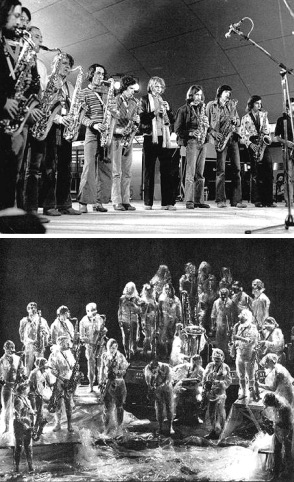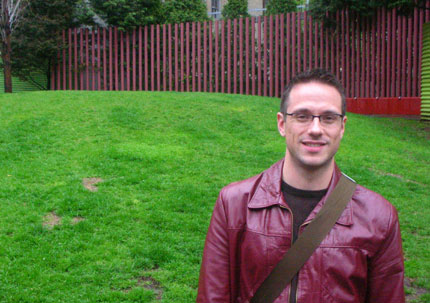Our regular listen to and look at living, breathing composers and performers that you may not know yet, but I know you should… And can, right here and now, since they’re nice enough to offer so much good listening online:
Gilbert Artman and Urban Sax (France)
 Urban Sax is a long-running ensemble / musical extravaganza founded by the French musician Gilbert Artman. It was was formed in 1973, when Artman organized a concert by a group of eight saxophonists at a classical music festival in the south of France. In subsequent years, the number of players grew to 12, 20, 30, and by now consists of 52 musicians (with saxophones ranging from the soprano to bass registers). Artman frequently integrates local musicians and dancers into his performances, and thus the ensemble can encompass as many as 200 performers.
Urban Sax is a long-running ensemble / musical extravaganza founded by the French musician Gilbert Artman. It was was formed in 1973, when Artman organized a concert by a group of eight saxophonists at a classical music festival in the south of France. In subsequent years, the number of players grew to 12, 20, 30, and by now consists of 52 musicians (with saxophones ranging from the soprano to bass registers). Artman frequently integrates local musicians and dancers into his performances, and thus the ensemble can encompass as many as 200 performers.
Urban Sax has performed throughout Europe and Asia. The group’s performances are art happenings; players wear metallic space suit-like costumes together with masks, and each performance is a unique event that is planned for the particular architectural or natural space where it takes place. The music is strongly minimal and ritualistic, as much about space and spectacle as anything else. Later, larger incarnations have the look of some mad cross between Sun Ra, Blue Man Group, and Cirque du Soleil. Another way of thinking about it is as a kind of sax analog to what Glenn Branca and Rhys Chatham were doing with guitars around the same time. It also seems to me to be a strong progenitor to all things “Bang-On-A-Can”.
The link at the top of this post will take you to the official Urban Sax website. It’s mostly in French, but for non-speakers there’s still plenty of photos, a discography, four short Quicktime movies of performances (in Lebanon, Tokyo, Versailles, and Dubai), and even a score to peruse.
BUT: What I really want you to do is take a listen to an MP3 file kindly parked on the web by NY/NJ’s greatest radio asset, WFMU. It’s the complete side one of Urban Sax 2, released in Europe in 1978. (Urban Sax 1 came out in 1977, with sides one and two called “part 1” and “part 2” respectively; Urban Sax 2‘s two sides were labeled “part 3” and “part 4”.)
The ensemble used in this recording: 27 saxophones (11 altos, 13 tenors, 2 baritones and 1 bass sax), a chorus of eight voices, and one tam-tam (played by Artman himself).
In 1979 I was a poor Air Force newbie, stationed in Wichita Falls, Texas. Bereft of my collection of records, scores and books, with no musical instrument at hand, my only connection to art-music was a few cassettes and a small, single-speaker player. But fate smiled in the form of the manager of a local mall record store, who beyond any hope or expectation happened to be a fellow progressive-music geek. He dubbed cassettes for me, of all kinds of obscure and wonderful things — and one of them was this very piece. Those tapes were musical life-savers for me, and will always remain full of charged memory. Eternal thanks, Larry (who I’m happy to report reconnected with me via the web! More than twenty years on now, he’s currently driving a bus in Austin.)
 To bolster that argument, let me point to two new Nielsen releases from DaCapo that have appeared so far this year. The first is a collection of his shorter opera and theater pieces called
To bolster that argument, let me point to two new Nielsen releases from DaCapo that have appeared so far this year. The first is a collection of his shorter opera and theater pieces called  As will
As will 
 Catch the show Friday and check out his new album called
Catch the show Friday and check out his new album called 
 It seems somehow fitting after a week of inexplicable madness that
It seems somehow fitting after a week of inexplicable madness that  Urban Sax is a long-running ensemble / musical extravaganza founded by the French musician Gilbert Artman. It was was formed in 1973, when Artman organized a concert by a group of eight saxophonists at a classical music festival in the south of France. In subsequent years, the number of players grew to 12, 20, 30, and by now consists of 52 musicians (with saxophones ranging from the soprano to bass registers). Artman frequently integrates local musicians and dancers into his performances, and thus the ensemble can encompass as many as 200 performers.
Urban Sax is a long-running ensemble / musical extravaganza founded by the French musician Gilbert Artman. It was was formed in 1973, when Artman organized a concert by a group of eight saxophonists at a classical music festival in the south of France. In subsequent years, the number of players grew to 12, 20, 30, and by now consists of 52 musicians (with saxophones ranging from the soprano to bass registers). Artman frequently integrates local musicians and dancers into his performances, and thus the ensemble can encompass as many as 200 performers.